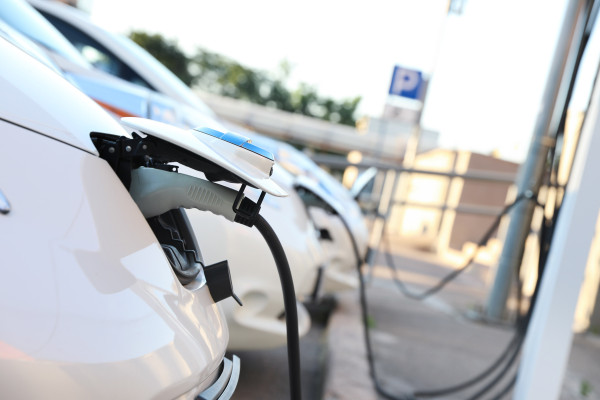EV charging PAS revisions offer updated guidance for residential and commercial EV users
How you charge your EV matters. It can reduce your charging costs, reduce emissions, and support New Zealand’s transition to renewable energy.
Gain insight to the latest advice on energy-efficient charging, good practice, and new technologies in our revised guidelines, commissioned by EECA (the Energy Efficiency and Conservation Authority).

A row of charging EVs
With around 500 extra EV vehicles on New Zealand’s roads each month, our growing fleet of low-emission vehicles has the potential to increase pressure on our national grid and energy prices. But there is a lot we can do to prepare and ensure that New Zealand is ready for the switch from fossil fuels.
So what’s the problem?
Changing from an internal combustion engine (ICE) vehicle to an electric vehicle (EV) means consumers need to think a bit differently about owning, running, and refueling their vehicle. Imagine if every household in New Zealand owned an EV and we all plugged them in at the same time (for example, on our return from work)? The electricity system would need dramatic investment to meet this additional demand which would result in higher electricity costs for everyone in New Zealand.
The solution
Increased uptake of EVs means that the energy landscape of New Zealand needs to adapt to the increasing demand for electricity. It will involve all of us – electricity network operators, electrical trades, suppliers, government regulators/policy makers, commuters, and consumers.
2021 saw the publication of the first version of SNZ PAS 6011:2021 Electric vehicle (EV) charging for residential use and the complementary SNZ PAS 6010:2021 Electric vehicle (EV) charging for commercial use. With publicly available specifications (PAS) providing a quick solution and market snapshot in such a rapidly evolving industry, it has become necessary to revise the original publications.
The updated PAS introduces the use of ‘smart’ charging, which will reduce costs for households, take pressure off the national electricity grid, and help reduce New Zealand’s carbon footprint through prioritising renewable energy. Smart EV chargers have built-in two-way communication capability and are able to vary charging, based on external signals. This will enable the user or a demand flexibility provider to increase or decrease charging levels when flexibility services become available in the NZ market in the near future. Demand flexibility and the cost savings available are often tied to the availability of lower-cost off-peak electricity – for example at night or in periods of lower grid demand.
Changes to these versions
Installation of EV chargers at commercial locations is more complex than at residential locations, hence a dedicated PAS for their specific needs. These PAS condense available information on the practicalities of charger types, design, permitting, installation, electrical safety requirements, and general points of EV charger specification. It also includes new aspects not addressed in current guidance, namely efficiency, smart charging, and interoperability as well advice on cybersecurity considerations. Referenced documents, definitions, and abbreviations have been updated, and the layout and sections modified.
Both specifications have also been renamed to SNZ PAS 6011:2023 Residential electric vehicle (EV) charging and SNZ PAS 6010:2023 Commercial electric vehicle (EV) charging.
Changes to the residential use PAS include:
- Section 4 explains the different types of EVs, the limitations of current technology and outlines demand response and demand flexibility. Information has been updated on electric vehicle supply equipment (EVSE) and the types of common plug and socket configurations (connectors) car manufacturers use – depending on which part of the world the vehicle was manufactured in.
- Section 3 focuses on assessing existing electrical load capacity where the new charger will be installed, EV charging station locations, and the futureproofing of your EV investment through choosing smart charging technology.
- Information on charging rates for EVs has been updated, and the difference between the different types of EV charging stations available has been expanded upon.
- Section 5 is now the technical specification and is primarily aimed at equipment suppliers and installers. It includes enhanced installation protocols, analysis of electricity capacity, and electrical safety and maintenance regimes. Greater clarity has been provided on grid connectivity and communication requirements, as well as cybersecurity. Lastly, this section contains a handy installation checklist and EV charging station reference tool.
Changes to the commercial use PAS include:
- The revised publication is now four sections (previously five). This was done because the original public charging ‘on-journey ‘component was creating confusion about requirements for smaller commercial enterprise and was not focused on destination charging. A separate ‘on-journey’ PAS with information on publicly available EV charging is currently under development.
- Section 2 has been updated to include a snapshot of the market to March 2023.
- The clauses on EV plug connector types have been updated to reflect current manufacturer requirements.
- There is a greater focus on demand-response and demand-flexibility and how the cost savings available relate to EVs.
- There are new clauses on ‘load management’, ‘grid-connectivity and communication protocols’, with a minimum specification set for EV charging stations, defining efficiency and connectivity, and providing guidance on cybersecurity requirements.
Written by experts, shaped by the sector
The revision saw nearly 600 public comments provided for consideration by the committee, who represents transport, electricity, and safety agencies, industry associations, regulators, and suppliers.
To date, there have been over 4,000 downloads of the existing EV PAS, which were sponsored by EECA. These PAS have offered invaluable guidance for those establishing a safe, efficient charging system based on good practice, designed by subject matter experts.
Using the PAS can benefit all New Zealanders. With a network of ‘smart’ energy-efficient EV charging stations, there will be reduced energy costs for consumers, a more stable electricity grid, and an important contribution towards New Zealand meeting its climate change and emissions-reduction targets.
